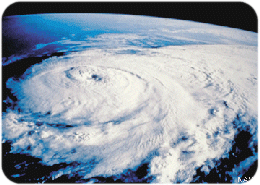![]()

![]()

![]()
![]()
![]()
![]()
Summer is here,
and the cold, gray waters of winter now beckon us to frolic along the
Atlantic Ocean shoreline, in the Gulf of Mexico, and among the Caribbean
Islands. But, beware! The lazy, hazy days of summer can also bring storm
surges, high winds, heavy rains, and tornadoes - - the hazards of hurricanes
that are born in warm tropical waters, then mature, ravage, and die, often
leaving mass destruction in their wake. Hurricanes aren't the largest
or most violent storm systems in our atmosphere, but they combine these
qualities like no other phenomenon.
The term "hurricane" echoes colonial Spanish and Caribbean Indian words for evil spirits and big winds. These awesome storms have been a deadly problem for residents and sailors since the early days of colonization. During the 20th century, 23 of the hurricanes that touched land caused damage in excess of $1 billion each. Damage from hurricane Andrew (1992) alone was estimated at more than $25 billion in South Florida and Louisiana.
The risk of harm from hurricanes increases every year as population and commercial, residential, and recreational development increase along popular coastal areas. But, thanks to improvements in forecasting and emergency preparedness resulting from active partnerships between Federal agencies, state and local agencies, and private and academic organizations, the numbers of injuries and deaths are declining steadily.